How Stem Cells Work: Science Made Simple
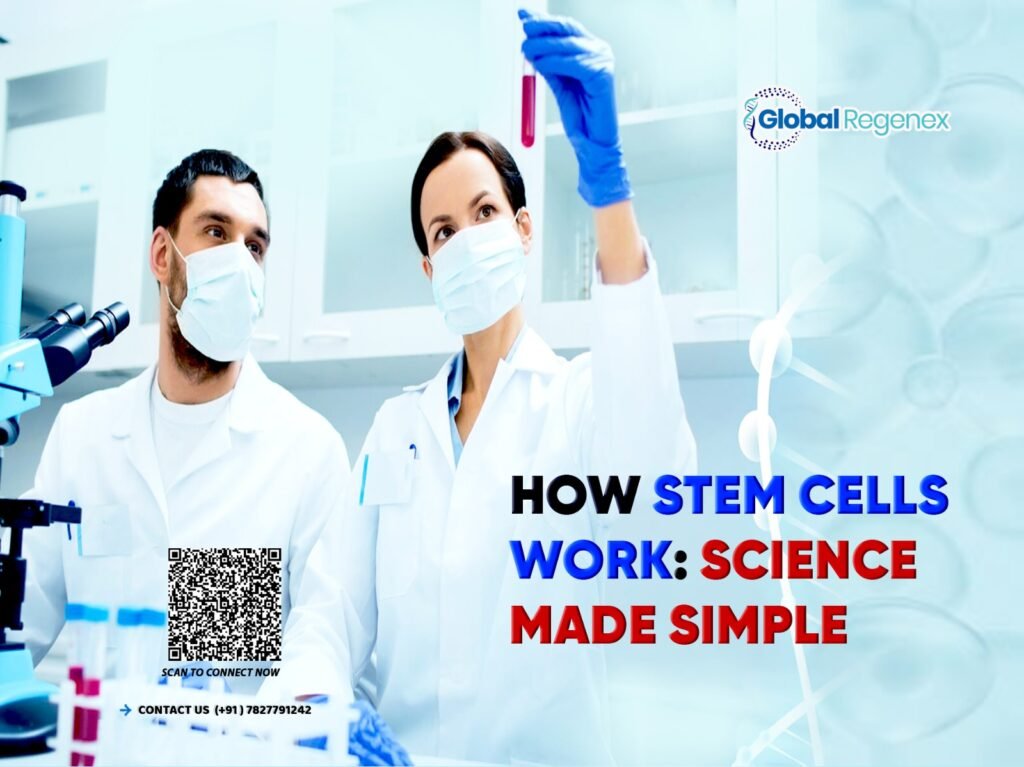
Summary: Stem cells are the body’s own repair system with the special power to self-renew and differentiate into specialized cells. They are responsible for growth, healing, and medical research. Located in such sites as bone marrow or induced as iPSCs, stem cells are the focus of regenerative medicine, holding promise for the treatment of severe disease and injury. How Stem Cells Work: Science Made Simple Millions of people around the world, one way or another, are dealing with some type of severe injury or condition. This makes it natural for them to look for more advanced treatment or therapy to overcome the condition. Fortunately, the treatment lies within the body itself, known as stem cells. In simple words, stem cells are the body’s tiny cells that can grow into different types of cells, such as muscle cells and more. To gain a deeper understanding of this topic and learn how stem cells function, continue reading the blog as we explore the world of regenerative medicine together. Additionally, if you are interested in stem cell treatment in India, consulting with Global Regenex for excellent guidance is a must. What Are Stem Cells? Stem cells are the building blocks of the body, which form more than 200 cells of the body, as they have the ability to differentiate into various types of cells, which also aid in replacing and repairing damaged cells. Unlike regular cells, which can only do a single task, stem cells can generate more stem cells or transform themselves into new cells when necessary. Key Points About Stem Cells: Self-Renewal: They always differentiate themselves again and again, as per the body’s need. Flexibility: They are versatile and can change into many types of cells, like blood, muscle, etc. Use in Medicine: Stem cells are currently being researched and studied for their medical applications. Doctors study them to treat diseases like diabetes, heart problems, and spinal injuries. Types of Stem Cells Adult Stem Cells are located in locations such as bone marrow and typically develop into some types of cells. Induced Pluripotent Stem Cells (iPSCs) are ordinary adult cells modified to behave like embryonic stem cells. How Do Stem Cells Function? They are considered special due to the ability to both replicate themselves and transform into other forms of cells that the body requires. Let’s see how they differ from regular cells, which can only do one specific task. How stem cells operate can be described in two general steps: Stem cells can easily divide repeatedly to generate more stem cells of the same type. This guarantees a sufficient supply is always present for growth and repair. Stem cells may become specific cells like blood cells, skin cells, muscle cells, or nerve cells based on signals from the body. For example, to understand this further, suppose you have a cut in your hand, stem cells in the skin will repair and replace the damaged cells and heal the wound. And to talk about the brain and spinal cord, in some cases, stem cells can even repair damage to nerves. Seeing the potential of stem cells, researchers are examining stem cells for the treatment of diseases like diabetes, heart disease, and spinal cord injury, to repair damaged tissues and improve healing in the area. Why Are Stem Cells Important? They are unlike other cells that become specialized to do one thing. Stem cells can replicate into additional stem cells or specialize into various cells, such as blood, nerve, or muscle cells. That is why they are significant in development, in healing, and in research. Significant reasons stem cells are significant: Growth and Development During infancy, stem cells develop all the tissues and organs of a developing infant. They remain active throughout life by contributing to normal development and repairing damaged or worn-out cells. Healing and Repair Stem cells in bone marrow continuously produce new blood cells that maintain the immune system. They repair wounds, damaged tissue, and even some organs by creating new, healthy cells. Medical Research Scientists research stem cells in an attempt to understand how disease occurs at the cellular level. They can be tested on with new medication and treatments without any danger. Regenerative Medicine Stem cells have the potential to repair or replace damaged tissues and organs. They also hold hope for curing diseases such as diabetes, heart disease, spinal cord injury, Parkinson’s disease, and certain types of blindness. They can minimize organ donor requirements by growing tissues in the laboratory. Putting It All Together Stem cells are so much more than small microscopic blocks; they are the future wave for renewal and creativity in medicine today. Repair, renewal, and regeneration through the assistance of stem cells are vital to the health of humankind and the advancement of science. And with additional research and treatment alternatives, stem cells bring a possibility of revolutionizing the way we treat disease and grow life back. Frequently Asked Questions (FAQs) Q.1 Can I Increase My Number of Stem Cells Naturally? Ans. Yes, you can also maintain stem cell health naturally by exercising regularly, getting good sleep, eating balanced food, fasting, and managing stress. Q2. How do Stem Cells Work Simply? Ans. Stem cells function by producing more stem cells and transforming into other types of cells, enabling the body to develop, repair, and recover. Q3. How Can I Keep My Stem Cells Healthy? Ans. You can maintain your stem cells in a healthy condition by exercising, having a balanced diet, sleeping comfortably, avoiding stress, and not smoking or drinking too much alcohol. Q4. Where Do Stem Cells Live in the Body? Ans. Stem cells reside in most regions of your body, especially in bone marrow, blood, brain, skin, muscles, and fat tissue.
Is Stem Cell Therapy Permanent?
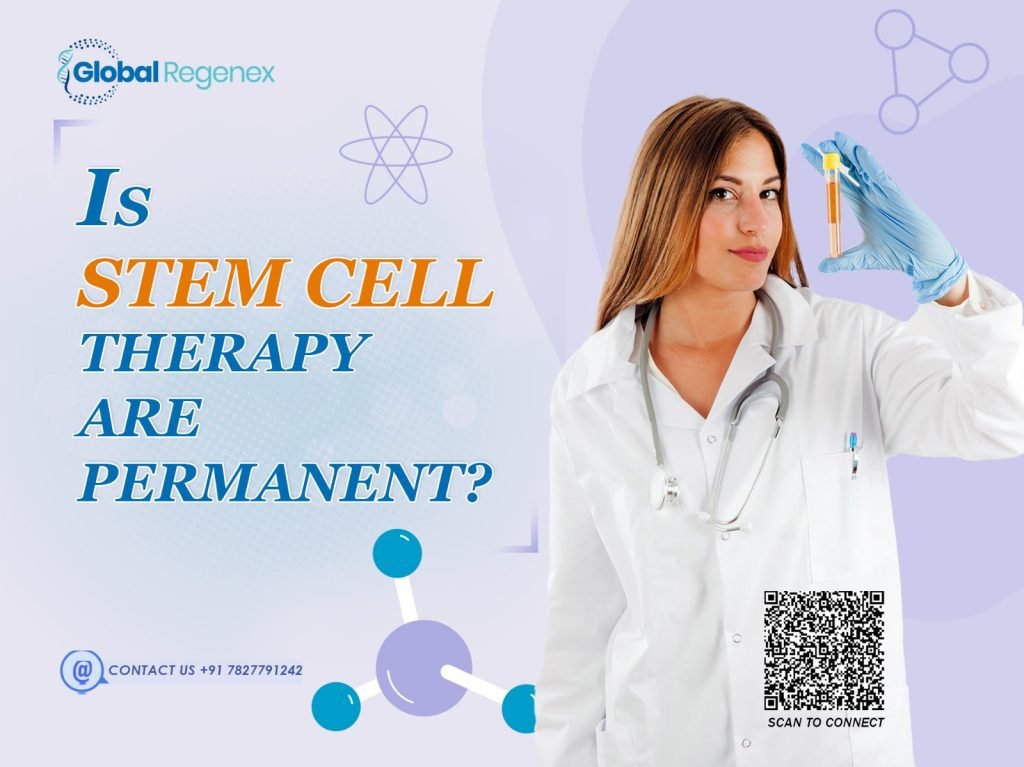
Are you struggling with severe conditions and tired of traditional treatment but still couldn’t find relief? It’s time to turn to stem cell therapy. An innovative regenerative medicine that has come forth as a potential treatment for many different types of diseases and conditions. This promotes healing through factors like replacing and restoring damaged tissues and cells in the body. Now, you are probably wondering if this treatment is permanent or temporary. With the increasing demand for stem cell treatment in India, more and more individuals are curious to know if it has long-term effects. The concept of using the regenerative power of the body feels so unreal, but does it really last forever? In this blog, let’s get into what makes this therapy revolutionary and if the results are truly permanent. Understanding the Scope & Effectiveness of Stem Cell Therapy What Are Stem Cells? Stem cells are tiny but powerful building blocks of life. They have the ability to differentiate into specialized cells like muscle, nerve, or blood cells. Stem cells facilitate the body’s ability to replace damaged tissues without the need for surgery. The regenerative power of stem cells has shown new ways to treat many different diseases like spine injury, neurodegenerative, etc. Overview of Stem Cell Therapy In the stem cell therapy procedure, stem cells are derived from the patient’s own bone marrow or fat, treated, and then injected into the affected part. Stem cells then start to repair damaged tissue and reduce inflammation to promote quick healing without surgery. Conditions Treated By Stem Cell Therapy Stem cell therapy can be used to treat a variety of medical conditions, such as: Neurological Disorders: Stem cell therapy is able to repair the regeneration of nerve cells and treat multiple sclerosis, Parkinson’s disease, and Alzheimer’s. Spinal Cord Injuries: The injured nerves will be repaired using stem cells that also restore feeling and movement to paralyzed patients. Diabetes: Stem cell therapy can potentially help in the regeneration of insulin secreting cells of pancreas. So, it is a new ray of hope for diabetic patients. Diseases of the Heart: Stem cells can heal damaged tissues after a heart attack and improve the functionalities of the heart. Orthopedic Conditions: Treat injuries of ligaments, arthritis, and other joint-related disorders to achieve pain relief and improved mobility for patients. Is Stem Cell Therapy Long-Term? Before undergoing the stem cell therapy, it is important to understand the therapy fully to set realistic expectations. Keep in mind that stem cell therapy is still in research, although it does show some promising results in treating various conditions. The effect of stem cell treatment can be long-term but not always permanent in every situation. The success is highly dependent on the condition the patient is being treated for, the age, and lifestyle. Some individuals have years of relief while others require follow-up treatments. Need Expert Advice? If you are looking for expert consultation to finalize your decision about undergoing stem cell therapy in Delhi, ask questions regarding the procedure, possible advantages, and more. Consulting with Global Regenex for all your questions on stem cell therapy and regenerative medicine, they have a team of experts who are ready to answer and guide you with every step of your stem cell treatment. Putting It All Together Is stem cell therapy permanent? Not necessarily. It does provide long-term relief and recovery for some patients, but the period of results varies with each patient and condition. Choose a reputable stem cell therapy provider center in India for experienced experts that offer individuals with stem cell treatment that are more successful and have long-lasting results. And it is always best to discuss with your specialist for proper expectations on your healing timeline.
How Are Stem Cells Produced In The Body?
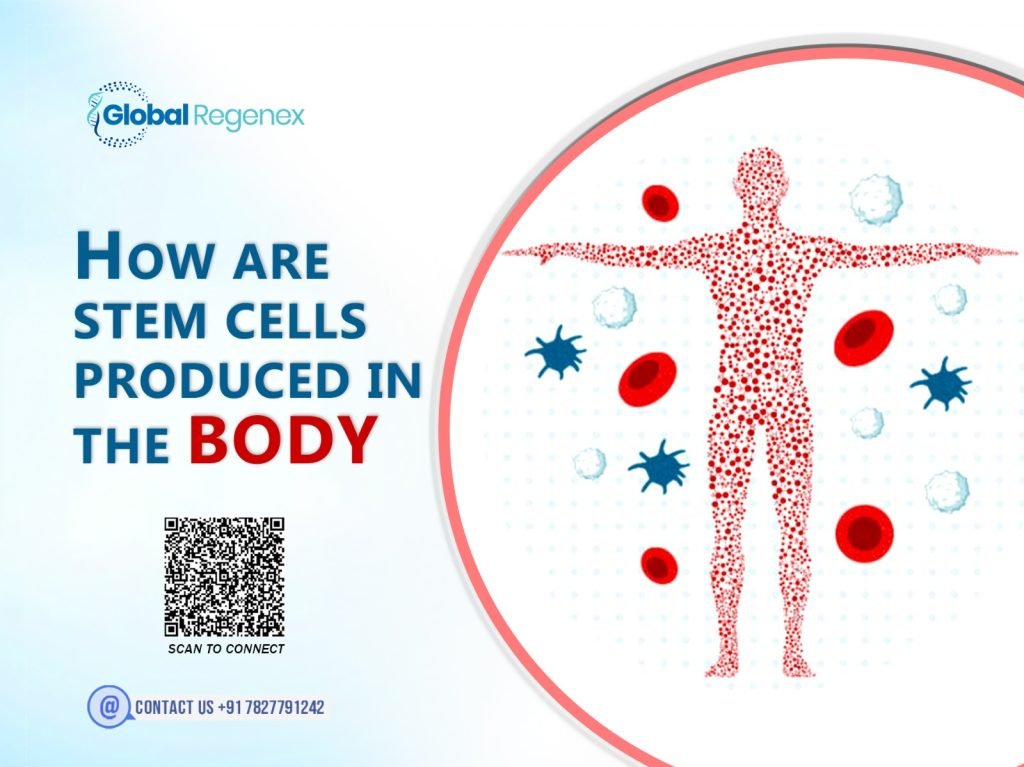
Stem cells, nowadays, have been creating waves in the regenerative medicine world, mostly with their power to treat a wide range of diseases. But do you know? How these powerful cells are produced in the body? Acknowledging the origin of this natural process can help you gain insight into the future of regenerative medicine, such as stem cell treatment in India. Additionally, if you are seeking stem cell treatment or just want to know more about regenerative medicin, consulting with Global Regenex would be a good idea. Understanding Stem Cells Before diving into the knowledge of production, let’s understand what stem cells are. They are the powerful body’s raw material cells, from which other cells are generated. These cells have two types of ability: Self-Renewal: These cells can divide into more stem cells. Differentiation: Stem cells can transform into many other types of cells in the body, like muscle cells, nerve cells, and more. The qualities mentioned above, make stem cell treatment in India a promising alternative treatment for many conditions. Where Do Stem Cells Come From? The human body produces stem cells naturally in various ways. Let us explore how various types of stem cells are obtained: Adult Stem Cells Adult stem cells are found within various tissues such as bone marrow, skin, and fat. They are multipotent in the sense that they differentiate into particular cell types but not into all of them. Bone Marrow Stem Cells: Produce blood cells such as red blood cells and platelets. Mesenchymal Stem Cells: found in tissues such as bone marrow, fat tissue, and umbilical cord tissue, and these make stem cell treatments for arthritis and spinal cord injury possible in Delhi. Induced Pluripotent Stem Cells Adult cells are now designed to basically have unlimited reproduction capacity, and now they can be watchmen for an embryonic cell-plus. How Are Stem Cells Naturally Produced in the Body? Stem cells possess a wonderful mechanism in the body that starts from their formation to survival. This is how it is: Stem Cell Niches In the body, stem cells are present in unique environments termed stem cell niches. These niches control stem cell activity, literally keeping them in a resting state until needed. Examples include: Bone marrow niches entice hematopoietic stem cells (blood-forming stem cells). Hair follicle niches support skin stem cells that are in charge of replacing hair and skin. The Process of Cell Division and Regeneration The body demands new cells. Therefore, stem cells divide, one daughter cell remaining a stem cell (in reserve) while the other becomes specialized. The cells, ranging from blood to skin to an interior lining of the digestive system, can continually regenerate themselves this way. Signals Role in Stem Cell Activation There is also the release of signals from the body, such as growth factors or hormones, which activate the stem cells to do their job whenever there is a need. Examples: Injury or Disease: If there is an injury, stem cells travel to the region of damage and repair it. Exercise and Diet: Research reveals that exercise on a regular basis and a well-balanced diet stimulate greater production of natural stem cells in the human body. The Future of Stem Cell Therapy with Global Regenex So advanced is regenerative medicine that the development of stem cell therapy in India has been quite rapid. Scientists are unfolding horizons for several diseases—characteristic of several orthopedic afflictions to neurologic diseases. Stem cell treatment is fast becoming popular due to the ease with which it can be accessed and improved outcomes. If you choose to undergo stem cell treatment in Delhi, then Global Regenex is a name that stands on solid grounds. Their specialists provide customized consultations, leading you to the finest solutions available regarding your situation. Putting All Together Whereas the body requires no introduction as the healing powerhouse, stem cells have a certain intrinsic significance in the process of repair and regeneration. Knowing how the cells are made, makes us value the great strides in the stem cell treatment in India. It holds significant potential, be it discovering stem cell treatments or simply appeasing oneself by curiosity about the various types of healing of the body. Curious to learn more? Post a query to Global Regenex for professional guidance in your path towards good health!
Facts About Stem Cell Therapy
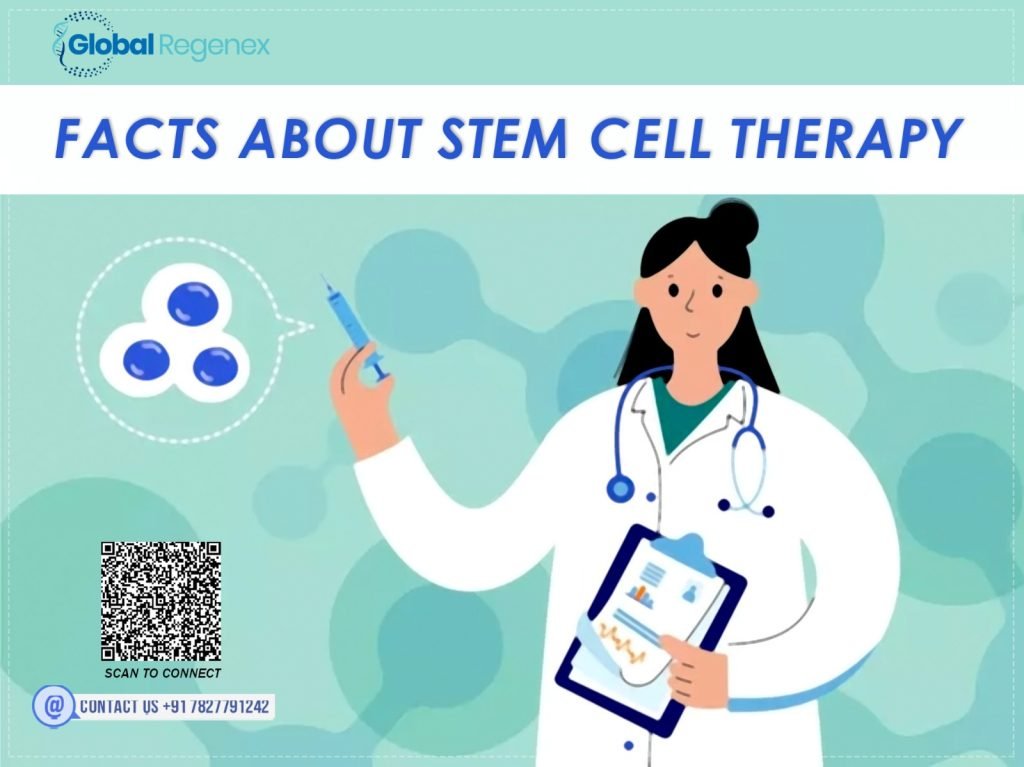
Have you wondered how modern regenerative medicine is pushing the boundaries of healing? Stem cell therapy is slowly becoming the epicenter and providing an alternative to surgery with less downtime. You might not know that there are some celebrities who, indeed, underwent stem cell therapy such as Cristiano Ronaldo, Max Scherzer, and more, to have pain-free treatment while avoiding the downtime that comes with surgery. While there is so much popularity of stem cell treatment in India also there are penalties of misinformation which leads to making wrong decisions, so it is important to consult with experts like Global Regenex, who has a team of experts specializing in regenerative medicine, to guide you in your journey to be healthy again. What Are Stem Cells? Stem cells are like repairmen of your body, they are the raw material of body cells, from which the other types of cells are derived. They have the power to transform into any type of damaged tissue or cells to heal the affected area. Stem cells can be transformed into nerve cells, blood cells, and more, with such versatility makes them valuable asset in regenerative medicine. What is Stem Cell Therapy? Stem cell therapy is basically a non-invasive and non-surgical process, which boosts the body’s natural healing process by injecting stem cells sourced from either the patient’s own bone marrow or through a donor. This is a safe and effective treatment that helps in: Repairing and regenerating damaged tissues. Eliminate inflammation and pain. Effectively heal the injuries and conditions. How Does Stem Cell Therapy Work? Stem cell therapy simply heals defective tissues and organs with their repairing or replacing by using these very efficient cells. The entire process generally involves: Extraction: Recovery of stem cells from some location like bone marrow, fat tissue, or the blood from the umbilical cord. Processing: Isolation and concentration of cells in a laboratory. Transplantation: Injections of stem cells that are processed into the patient’s system so they will stimulate healing and regeneration. This is why it is now utilized to treat many things, including orthopedic trauma debilitating and elusive diseases such as diabetes, or even neurological disorders. Conditions Treated Through Stem Cell Therapy Among several other applications, stem cell therapy is performed for: Orthopedic Issues Arthritis, painful joint, or sports injury. Neurological Illness Parkinson’s, Alzheimer’s, and spine disorders. Autoimmune Disorders like Multiple sclerosis, lupus, and rheumatoid arthritis. Oncological Disorders such as Diabetes, heart condition, and cirrhosis of the liver. It is vital that you arrange an audience with the experts. Global Regenex experts in personalizing the necessary stem cell solution for you according to your needs. How Long Does Stem Cell Therapy Last? The answer to this question depends on the person’s treatment plan and condition, in which treatment is being performed and how much damage has been done by the disease or injury. For some patient, stem cell therapy in Delhi acts as the last treatment they need to recover from the condition or injury and to get back to their active life. However, for some patients with slow healing power, it might take a few more rounds of stem cells to heal and live pain-free. Is Stem Cell Therapy Safe? The issue of safety in this area is valid and of great concern. Stem cell therapy is generally considered safe when conducted by qualified practitioners. Above all, ensure that you select a trustworthy clinic like Global Regenex, that has established its credentials. Always ask where the stem cells originate, what the success rates are for a specific treatment, and what potential dangers come along with it. The Future of Stem Cell Therapy The scope of stem cells is actually vast. Whether stopping aging or offering cures for diseases that have been untreatable in the past, scientists have focused on introducing new uses. With technology evolving, stem cell therapy should improve and become more accessible. Where to Consult with a Stem Cell Therapy Expert? If the thought of treating yourself with a stem cell therapy has crossed your mind then, Global Regenex is your partner in such endeavors. With experienced specialists reminding you under the care of the attending physician, personalized treatment plans are drawn in understanding to bring you the desired results. Be it for chronic pain, autoimmune conditions, or sports injuries, Global Regenex provides insight and expertise every step of the way. The Concluding Thoughts Stem cell therapy is revolutionizing, actually revolutionizing the concept of healing and recovery for every other aspect. As technology has progressed to repair injured tissues and cure numerous ailments, it is no surprise to observe how much interest stem cell therapy in India is gaining year after year. Today is the time for individuals in general to learn more about this revolutionary alternative treatment. To get started, contact Global Regenex and learn how stem cell therapy can be a true game-changer in your life and health. Welcome to the medical future, so tune in!
What Is The Success Rate Of Stem Cell Therapy In India?
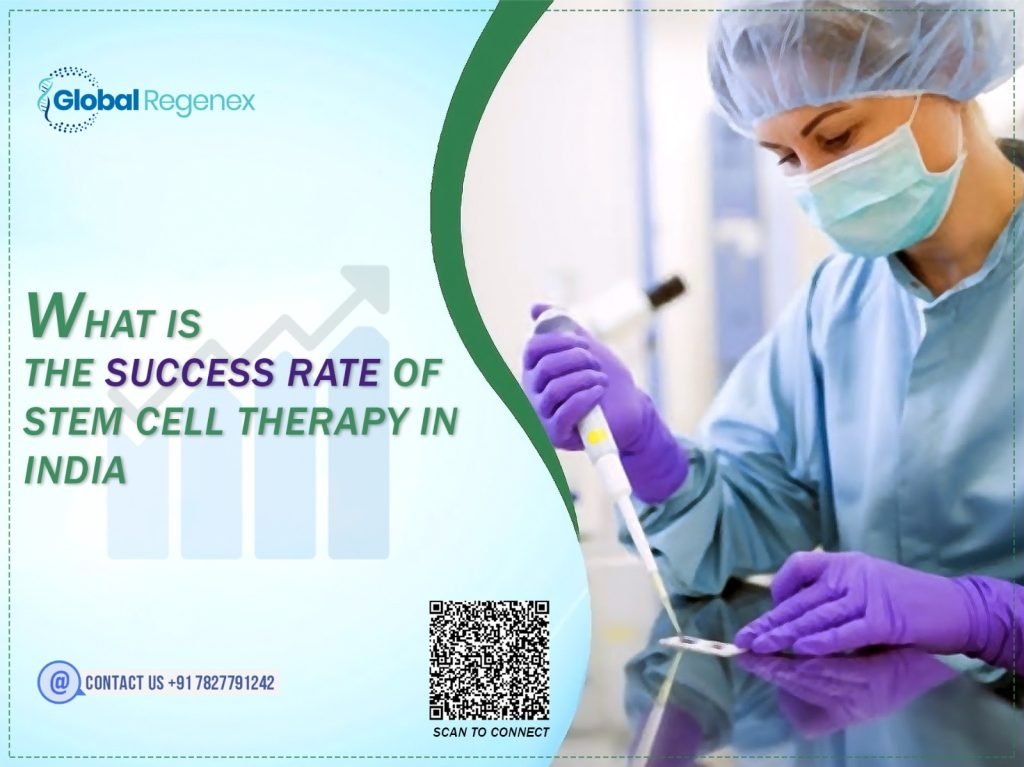
With increased research in the area of regenerative medicine, stem cell therapy is emerging quickly as a revolutionary cure for the majority of degenerative and chronic illnesses. Still, the question arises does it work, and should the patients choose to receive this sort of treatment? It is true factor that India has emerged as the world hub for the treatment using stem cells in advancing medical technology. A new therapy is used in patients with neurological defects, orthopedic ailments, and autoimmune diseases. However, what does it say about the success rate? Let’s look at the success rates of stem cell treatment in India. Overview of Stem Cell Therapy Stem cells are incorporated into the body for the purpose of replacement, regeneration, and repair of damaged bodily tissues. One of the remarkable features that has made it successful in treating conditions like diabetes, autoimmune diseases, neurological disorders, and orthopedic issues is the ability to differentiate into a wide variety of cell types. Types of Stem Cells Stem cells are differentiated according to their origin and ability to differentiate. The major categories of stem cells that are applied in therapy are listed below. Adult Stem Cells (ASCs): These cells are present in tissues like fat and bone marrow and are responsible for the repair and regeneration of tissues. Induced Pluripotent Stem Cells: These are adult cells, genetically reprogrammed to have characteristics similar to those of embryonic stem cells. Mesenchymal Stem Cells (MSCs): Because of their anti-inflammatory and regenerative abilities, MSCs, obtained from bone marrow, umbilical cord, and adipose tissue, are some of the most frequently used cells in regenerative treatments. Success Rate of Stem Cell Therapy in India India is now becoming a hub for the treatment of stem cell therapy. The easy and highly cost-effective advanced medical infrastructure in this country brings patients from around the world. Studies say good results here, especially for blood diseases, joint regeneration, and for neurological problems. India’s making great strides in this direction! Brain Disorders: Recovery rate from 50% to 80%, showing remarkable results in cerebral palsy, Parkinson’s disease, and spinal cord injuries. Orthopedic Conditions: Success rate between 60% to 85% in the case of ligament injuries, osteoarthritis, and cartilage regeneration; pain relief and improvement in mobility in many patients. Autoimmune Disorders: Excellent results for such patients with autoimmune disorders as lupus and multiple sclerosis have gone from 55% to 75% and above, as reported, having a significant positive effect on such conditions. Management of Diabetes: Results so far include an improvement in both insulin sensitivity and function of the pancreatic the overall success rate in current studies and case reports has ranged from 40% to 70%. For Expert Advice If you’re thinking of opting for stem cell therapy in Delhi for yourself or for a loved one, talking to an expert before the treatment is a good idea. Global Regenex is your reliable consultant that will connect you to advanced medical facilities. They will guide you expertly, formulate personalized treatment plans, and assist you throughout the process. The Concluding Thoughts Stem cell treatment has been producing fantastic results in India for a majority of medical conditions. Recent progress, sound moral behavior, and reasonable charges have made it a favorite destination for patients looking for regenerative treatments. If you are now considering your options for stem cell treatment, Global Regenex can help you move forward with confidence and experience.
What Diseases Do Stem Cells Treat?
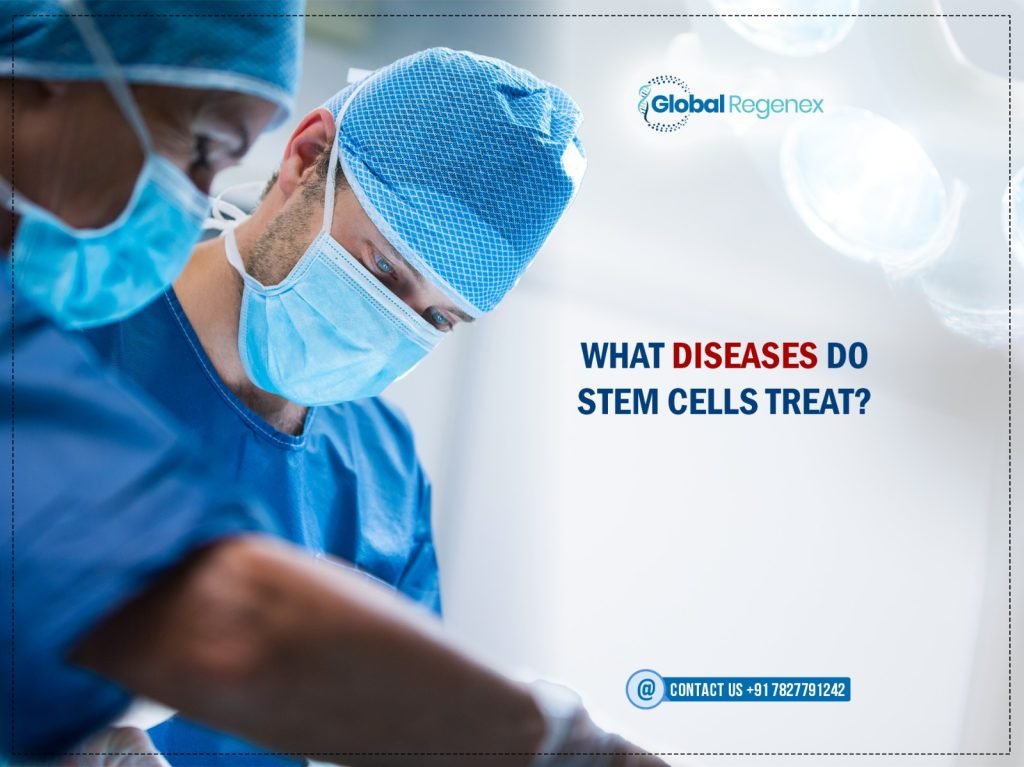
In recent years, chronic diseases are spreading rapidly all over the world and controlling them has become a mission. Chronic diseases are those diseases which can not be treated or cured by any kind of treatment. But, researchers and scientists find a way or we can say a treatment that helps in managing the symptoms of these diseases. Yes, we are talking about stem cell treatment. Stem cell treatment in India has become an optimal choice for every patient who is suffering from such diseases as liver disease, cerebral palsy, male infertility, and many more. Stem cell therapy is a treatment where stem cells are used to help the body heal itself. With the help of this blog, we will provide you with the information about stem cells, diseases that can be treated, and their importance. It will be fun and informative, so stay with the blog till the end. You will know more about the evolution of the medical industry. What Are Stem Cells and Their Properties? Stem cells are those unique that can be found in our body. These cells can be useful in various ways including making regenerative medicine. By using their regenerative properties, many chronic diseases can be managed and also stop the progression. However, these cells are still in their experimental stage but they can treat a large number of diseases. Stem cells are mainly adult stem cells. Adult stem cells are found in various tissues such as bone marrow. Various stem cell therapy centers in India are using these cells to reduce the symptoms of the diseases and provide quality of life to the patients. Stem cells find injured or damaged cells in the patient’s body and replace them with the new ones to provide healing. Now, we will show you some powerful properties of these cells which are: Self-renewal: Stem cells can divide and create more stem cells, which means they can keep making new cells over a long period. Differentiation: Stem cells can transform into specialized cells, like muscle cells, nerve cells, or blood cells, which perform specific functions in the body. Pluripotency: Some stem cells have the ability to become any type of cell in the body, making them highly versatile for medical research and treatment. Multipotency: Adult stem cells can turn into a limited range of cell types, usually related to the tissue they come from, like blood or bone cells. Regenerative potential: Stem cells can repair and replace damaged tissues, which is why they are used in treatments for diseases and injuries. Proliferation: Stem cells can multiply rapidly, producing a large number of cells that can be used for therapies and scientific studies. Different Types of Disease That Can Be Treated With Stem Cells Stem cells are becoming a hope of many patients due to its remarkable results and beneficial properties. These cells have differentiative properties which helps them to differentiate into special types of cells. After that, these special cells attack the damaged part of the body and start the process of healing. Rather than differentiation, stem cells also have anti-inflammatory properties, regenerative properties which makes them an optimal choice for treatment. Here are some diseases that can be treated with stem cells: Osteoarthritis: This is a common joint disease that causes pain and stiffness. Stem cells can help repair the damaged cartilage, reducing pain and improving joint function. Critical Limb Ischemia: This severe condition results from blocked arteries in the legs. Stem cells can promote the growth of new blood vessels, improving blood flow and potentially saving the limb. Crohn’s Disease: This is a chronic inflammatory bowel disease. Stem cell therapy can reduce inflammation and promote healing in the intestines, offering relief from symptoms. Non-healing Diabetic Ulcers: These are sores that do not heal due to diabetes. Stem cells can accelerate the healing process by promoting new tissue growth, reducing the risk of severe complications. Avascular Necrosis: Avascular necrosis occurs when bone tissue dies due to a lack of blood supply. Stem cells can help regenerate the bone tissue, preventing further damage and restoring function. But these are not only the diseases that stem cells treat. There are some other diseases too such as neurological diseases, orthopedic conditions, infertility in male and females, etc. When you go down to the details of these cells you will find some amazing facts about them. Many centers and stem cell therapy hospitals are doing their great best by providing this innovative treatment. Benefits of Stem Cells in Treatment Stem cells have various unique abilities and one of them is restoration and regeneration. These are the abilities which make these cells an optimal choice to use in various treatments. Stem cells can treat a vast number of diseases and help the patient’s body to overcome the symptoms. Overall, stem cells are a powerful tool in the fight against many health problems. Here are some benefits of stem cells that you can experience in your treatment: Repairing Damaged Tissues Stem cells can become the type of cells needed to repair damaged tissues, such as heart muscle after a heart attack. Replacing Lost Cells They can replace cells that are lost due to diseases like diabetes, where insulin-producing cells are destroyed. Treating Genetic Disorders Stem cells can be used to correct genetic defects, offering potential cures for conditions like sickle cell anemia. Testing New Drugs Scientists can use stem cells to test the safety and effectiveness of new drugs without using human subjects. Understanding Diseases Studying stem cells helps scientists learn more about how diseases develop, which can lead to new treatments. Personalized Medicine Stem cells can be used to create personalized treatments for patients, tailoring therapy to the individual’s needs for better outcomes. The Concluding Remarks Stem cells are known as the innovative medical approach because of their successive results and beneficial properties. These cells can restore or replace the old damaged cells with the new ones to stop the progression of the disease and reduce the symptoms. But, it should
What is Stem Cell Treatment and Their Types?
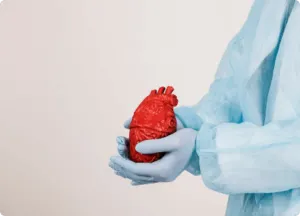
Stem cell treatment, also known as regenerative medicine, involves the use of stem cells to repair, replace, or regenerate damaged tissues and organs. Stem cells are unique because they can develop into many different types of cells in the body, offering the potential to treat a wide range of diseases and injuries. They can differentiate into specialized cell types, such as muscle cells, nerve cells, or blood cells, and self-renew to produce more stem cells. Stem cell treatments can involve the direct injection of stem cells into the damaged area, or the use of stem cells to grow new tissues in a lab, which are then transplanted into the patient. The goal is to leverage the natural regenerative capabilities of stem cells to restore function to damaged tissues. Types of Stem Cells Several types of stem cells are used in treatments, each with unique properties and potential applications. The main types include: Embryonic Stem Cells (ESCs) Adult Stem Cells (ASCs) Induced Pluripotent Stem Cells (iPSCs) Perinatal Stem Cells 1) Embryonic Stem Cells (ESCs) Characteristics: Pluripotent: ESCs can differentiate into any cell type in the body. Source: Derived from early-stage embryos, typically from excess embryos created during in vitro fertilization (IVF) procedures. Potential: High potential for generating all cell types, offering possibilities for treating a wide range of diseases and injuries. Applications: Research: Extensively used in research to understand early human development and disease mechanisms. Therapeutics: Potential for treating conditions like spinal cord injuries, diabetes, Parkinson’s disease, and heart disease. However, ethical concerns and the risk of immune rejection limit their current clinical use. 2) Adult Stem Cells (ASCs) Characteristics: Multipotent: ASCs can differentiate into a limited number of cell types related to their tissue of origin. Source: Found in various tissues throughout the body, including bone marrow, fat tissue, and blood. Potential: Less versatile than ESCs but more readily accepted for therapeutic use due to fewer ethical issues and lower risk of immune rejection when using autologous cells (from the same patient). Types and Applications: Hematopoietic Stem Cells (HSCs): Found in bone marrow and blood, these cells can form all types of blood cells. Used in treatments for blood disorders like leukemia and lymphoma. Mesenchymal Stem Cells (MSCs): Found in bone marrow, fat tissue, and other tissues. Can differentiate into bone, cartilage, muscle, and fat cells. Used in regenerative therapies for joint repair, bone regeneration, and treatment of inflammatory conditions. Neural Stem Cells: Found in the brain and spinal cord. Potential applications in treating neurological disorders such as Parkinson’s disease, multiple sclerosis, and spinal cord injuries. 3) Induced Pluripotent Stem Cells (iPSCs) Characteristics: Pluripotent: Similar to ESCs, iPSCs can differentiate into any cell type. Source: Created by reprogramming adult somatic cells (such as skin cells) to an embryonic-like state by introducing specific genes. Potential: Combines the versatility of ESCs with the ethical acceptability of ASCs. iPSCs can be patient-specific, reducing the risk of immune rejection. Applications: Disease Modeling: Used to create disease-specific cell lines for research, aiding in studying disease mechanisms and drug development. Regenerative Medicine: Potential for personalized cell therapies and tissue regeneration, including treatments for heart disease, diabetes, and neurological disorders. Drug Screening and Development: iPSCs are used to test the efficacy and safety of new drugs on human cells. 4) Perinatal Stem Cells Characteristics: Pluripotent or Multipotent: Perinatal stem cells can differentiate into multiple cell types, but their exact potential can vary. Source: Derived from perinatal tissues, such as the placenta, umbilical cord blood, and amniotic fluid. Potential: Readily available and less ethically contentious compared to ESCs. They offer a promising source of stem cells for various therapies. Types and Applications: Umbilical Cord Blood Stem Cells: Rich in HSCs, used for treating blood disorders and immune system deficiencies. Placental Stem Cells: Contain various types of stem cells with potential applications in regenerative medicine, including wound healing and organ repair. Amniotic Fluid Stem Cells: Can differentiate into multiple cell types, with potential applications in treating congenital anomalies and tissue repair. Applications and Benefits of Stem Cell Treatment Regenerative Medicine and Tissue Engineering: Stem cells can regenerate damaged tissues, offering potential treatments for conditions like heart disease, stroke, spinal cord injuries, and arthritis. In tissue engineering, stem cells are used to grow tissues and organs in the lab, which can then be transplanted into patients. Cancer Treatment: Hematopoietic stem cell transplants (bone marrow transplants) are used to treat blood cancers such as leukemia and lymphoma. Research is ongoing into using stem cells to deliver targeted cancer therapies. Neurological Disorders: Stem cell therapies are being explored for treating neurodegenerative diseases like Parkinson’s, Alzheimer’s, and multiple sclerosis. They hold the potential for repairing spinal cord injuries and restoring function in damaged neural tissues. Autoimmune and Inflammatory Diseases: Mesenchymal stem cells have immunomodulatory properties that can help treat autoimmune diseases such as rheumatoid arthritis, Crohn’s disease, and lupus. They can reduce inflammation and promote tissue repair in conditions like chronic obstructive pulmonary disease (COPD) and inflammatory bowel disease (IBD). Aesthetic and Anti-Aging Treatments: Stem cells are used in cosmetic procedures for skin rejuvenation, wrinkle reduction, and hair restoration. They promote collagen production and improve skin elasticity and texture. Orthopedic Applications: Stem cells are used to treat joint injuries, osteoarthritis, and fractures by promoting cartilage and bone regeneration. They can accelerate the healing of tendon and ligament injuries. Cardiovascular Diseases: Stem cell therapies are being developed to repair heart tissue damaged by myocardial infarction (heart attack) and to improve vascular regeneration in conditions like peripheral artery disease. Wound Healing and Burns: Stem cells can enhance the healing of chronic wounds and burns by promoting tissue regeneration and reducing scarring. Challenges and Future Directions Ethical and Legal Issues: The use of embryonic stem cells raises ethical concerns due to the destruction of embryos. Regulatory frameworks vary across countries, affecting the research and application of these cells. Technical and Scientific Challenges: Ensuring the safety and efficacy of stem cell treatments is crucial. Risks such as immune rejection, tumor formation, and uncontrolled differentiation need to be carefully managed. Standardizing protocols for stem cell isolation, culture, and transplantation is essential to ensure consistent and reproducible results. Cost and Accessibility: Stem cell treatments can be expensive and may
